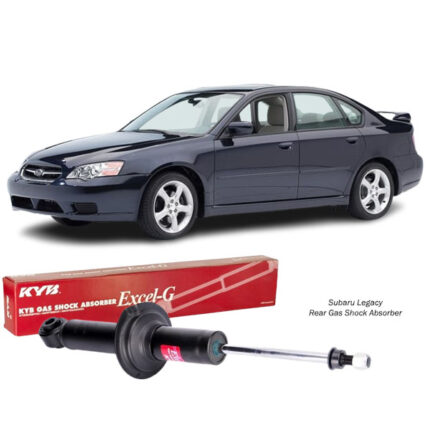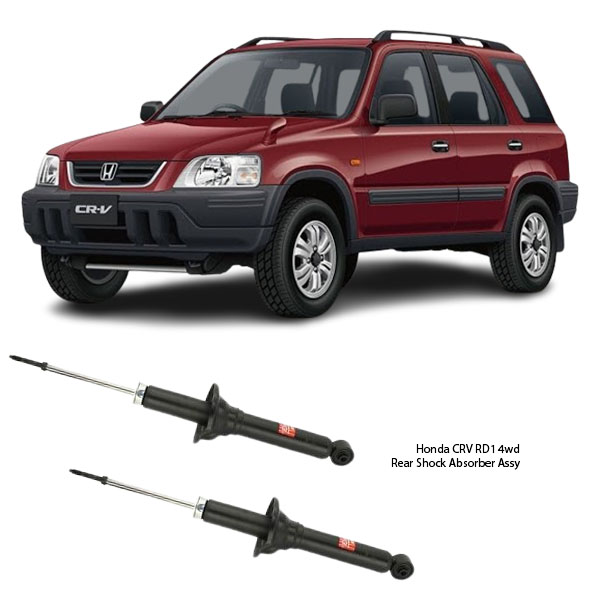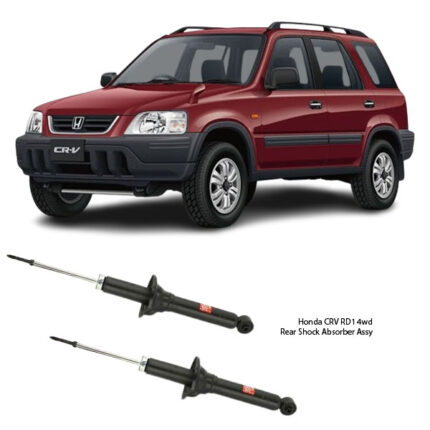-6%
Get Honda CR-V RD1 4WD 2.0-16V Rear Shock Absorber Assy 341261 in Kenya
In the world of automotive maintenance, few components play as crucial a role in comfort, stability, and safety as the rear shock absorber assembly. Whether you’re driving a compact car, SUV, or heavy-duty truck, shock absorbers ensure that your vehicle handles predictably and absorbs the impact from road irregularities.
Let’s dive deep into what the rear shock absorber assembly is, how it functions, why it’s essential, and how to know when it needs replacing.
What is a Rear Shock Absorber Assembly?
The rear shock absorber assembly is a key component of a vehicle’s suspension system, specifically located on the rear axle. Its primary function is to dampen or absorb the vibrations and shocks transmitted through the wheels when the vehicle encounters uneven surfaces, potholes, bumps, or obstacles on the road.
While the term “shock absorber” is commonly used, what’s often installed is a shock absorber assembly, which may include:
-
The shock absorber (damper) itself.
-
Coil spring (in some configurations, such as struts or coil-over shocks).
-
Mounting bushings and hardware.
-
Protective boots or dust covers.
In many modern vehicles, especially SUVs and trucks, the rear suspension uses separate shock absorbers and coil springs, but in some models (like rear strut setups), the components are integrated.
Function of Rear Shock Absorbers
Shock absorbers work on hydraulic or gas pressure principles. Inside the shock absorber, a piston moves through fluid or gas as the vehicle moves, converting kinetic energy from bumps and dips into heat energy, which is then dissipated.
Key functions include:
-
Controlling Suspension Movement
-
They prevent the rear end of the vehicle from bouncing excessively after hitting a bump.
-
-
Improving Tire Contact
-
By keeping the tires firmly pressed to the road, shocks improve traction, braking, and stability.
-
-
Reducing Wear on Other Components
-
A smooth ride means less stress on bushings, ball joints, control arms, and tires.
-
-
Enhancing Driving Comfort
-
Shocks dampen harsh movements, making the ride smoother for passengers.
-
-
Maintaining Alignment
-
Proper damping prevents erratic wheel movement that can throw off alignment.
-
Signs of a Worn Rear Shock Absorber Assembly
Rear shock absorbers don’t usually fail all at once, but they degrade gradually. Here are common signs that replacement may be needed:
-
Bouncy or Unstable Ride
-
If the rear of your vehicle feels like it’s floating or bouncing too much, especially after going over a speed bump, the shocks may be worn out.
-
-
Uneven Tire Wear
-
Damaged shocks can cause the tires to hop or lose consistent road contact, leading to scalloped or cupped tire wear patterns.
-
-
Fluid Leaks
-
A tell-tale sign of failure is oil leaking from the shock body. This means the internal seals have worn and the shock is no longer functioning properly.
-
-
Rear-End Dipping
-
When braking, if the rear of the vehicle seems to rise while the front dips aggressively, it may be due to weakened rear shocks.
-
-
Clunking or Knocking Noises
-
Worn-out mounting bushings or damaged shocks may cause noise over bumps or when the vehicle moves.
-
-
Longer Stopping Distances
-
Poor damping affects braking efficiency, especially during sudden stops or on rough roads.
-
Importance of Timely Replacement
Driving with worn rear shock absorbers is not just uncomfortable — it’s also unsafe. Here’s why timely replacement is essential:
-
Improves Road Safety: Shocks directly impact your vehicle’s ability to brake and steer effectively.
-
Prevents Damage: Poor suspension can lead to early failure of other parts such as tires, springs, control arms, and CV joints.
-
Enhances Comfort: A good set of shocks transforms the ride quality, especially on rough roads.
-
Protects Cargo and Passengers: Especially in pickup trucks and SUVs, bad shocks can cause bouncing that damages cargo or unsettles passengers.
Types of Rear Shock Absorber Assemblies
Depending on the vehicle type and suspension design, the rear shock absorber assembly can vary:
-
Twin-Tube Hydraulic or Gas Shocks
-
Most common. Affordable and suitable for regular use.
-
-
Monotube Shocks
-
Offer better performance, often used in performance vehicles or heavy-duty trucks.
-
-
Coil-over Shocks
-
Combine a shock and a spring in one unit, common in modern suspension setups or performance builds.
-
-
Strut Assemblies
-
In some vehicles (especially compact cars), the rear suspension may use struts instead of simple shock absorbers.
-
Rear Shock Absorber Replacement Process
Replacing a rear shock absorber assembly usually involves:
-
Lifting the vehicle safely using a jack and jack stands.
-
Removing the rear wheels to access the shock.
-
Unbolting the top and bottom mounts of the shock absorber.
-
Removing the old shock and replacing it with a new one.
-
Securing all bolts to manufacturer torque specs.
In some vehicles, the shock assembly may also include alignment or sensor components (for active suspension systems), so it’s best to consult a technician or service manual.
Genuine vs. Aftermarket
When purchasing replacement shocks, you typically have two options:
-
Genuine OEM Parts
-
Manufactured to factory standards. Reliable but can be more expensive.
-
-
Aftermarket Shocks
-
Brands like KYB, Monroe, Bilstein, and Sachs offer high-quality alternatives. Some may offer better performance or longer life than the originals.
-
At Onestop Garage & Auto Spares, we stock both genuine and trusted aftermarket shock absorber assemblies, tailored to meet your budget and performance expectations.
Choosing the Right Rear Shock Absorber
To select the right rear shock absorber assembly:
-
Know your vehicle’s make, model, and year.
-
Check your suspension type (strut or shock).
-
Confirm any special requirements like load-adjusting shocks for heavy-duty vehicles.
-
Consult your mechanic or parts specialist.
Available at Onestop Garage & Auto Spares
At Onestop Garage & Auto Spares, we provide high-quality rear shock absorber assemblies for a wide range of vehicles — from Japanese brands like Toyota and Mitsubishi to European and German models.
-
Professional fitting services available.
-
Countrywide delivery.
-
Affordable pricing on both genuine and premium aftermarket options.
-
Booking available online via our website.
Whether you’re dealing with ride comfort issues or prepping your car for long-distance travel, we’ve got you covered.
Conclusion
The rear shock absorber assembly is a small but vital part of your vehicle’s performance and safety. It cushions the ride, stabilizes your car, and helps maintain control. Ignoring the signs of wear can lead to discomfort, unsafe handling, and damage to other parts of the vehicle.
Whether you’re a car owner doing routine maintenance or an auto technician sourcing reliable parts, investing in a quality rear shock absorber assembly pays off in ride quality, safety, and peace of mind.
Follow us on Facebook for more parts.




